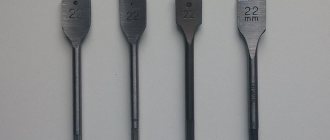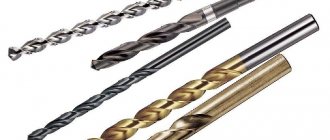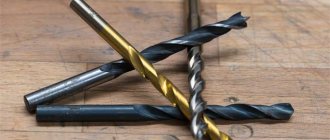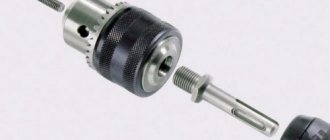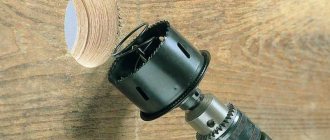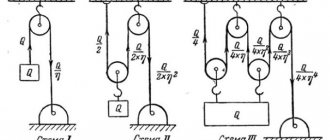How to choose a drill for a hammer drill
A drill is a specific work accessory, which among household electrical tools is used exclusively with rotary hammers and impact drills and screwdrivers.
Used to create holes in surfaces made of durable materials: for example, brickwork, concrete structures, stone. This type of equipment performs a wide range of tasks. Useful in repair work and construction. Due to this, novice craftsmen are often interested in how to choose a drill for a rotary hammer. The standard working element of a rotary hammer consists of several main elements:
- Shank at the rear of the tool. For this, the part is installed in the chuck of the power tool. There are different types, we’ll look at them in more detail later.
- Spiral.
- Dust removal cavity. During drilling, a large volume of construction waste accumulates. The removal of fine dust particles through a special groove maintains high performance.
- The carbide cutting insert is the tip of the tool. Its quality and condition affect its durability: pay attention to how firmly the part is attached. It should be in the center. Watch for wear: After prolonged use, the carbide insert will no longer penetrate the material effectively and the cutting tool will need to be replaced.
Drill and drill differences
The drill and the drill are cutting tools. When working with each of them, cylindrical recesses or holes are obtained. At first glance, this suggests that the drill and the drill are practically indistinguishable.
However, the answer to the question of how a drill differs from a drill is not so simple. Each tool has many varieties, but you can clearly define what is classified as drills and what is classified as drills. There is one important criterion for this.
So, first things first.
articles
These cutting tools can be used to make holes or indentations in almost anything:
- wood and materials based on it (chipboard, OSB, fiberboard, etc.);
- plastic;
- metal;
- stone;
- ceramics;
- brick, concrete and so on.
The difference between a drill and a drill is that it is usually used for processing durable, non-shock-absorbing materials - concrete, stone. A drill is better suited if you need to drill through softer and more elastic materials: wood, plastic. Metal, although it has great strength, is an elastic, springy material, so it is also processed with a drill. Let's look at what this is connected with below.
Drills and drills for concrete: differences and application features
28.07.2016
A drill is a cutting tool for creating through or blind holes in a material, as well as for increasing the diameter of existing holes (drilling operation).
Different types of drills are designed to work with specific materials: metals, plastics, natural or artificial stone, brick, concrete pavement, etc.
It should be noted that, unlike end mills, drills cannot move along the workpiece and remove material from the surface - they are designed only for axial load.
There are drills of other designs (where a conical or tetrahedral shank is used instead of a cylindrical one, and the cutting cone has a tricky shape). However, the twist drill described above is the most versatile for a wide range of jobs in industry and construction.
Structurally, the drill is:
- cutting cone (in the front part) with sharp edges - the sharpening angle affects the characteristics of the drill and is determined by the type of material being processed;
- spiral grooves for removing chips from the cutting area - their shape determines the speed of chip removal and drilling performance (as well as heating of the tool itself);
- and a smooth cylindrical shank for attaching the drill to the tool chuck.
What is the difference between a drill and a concrete drill?
A standard drill bit for impact drills/drivers for concrete has the following differences from a drill:
- Shank type. In drills for rotary hammers SDS-Plus and SDS-Max, in drills - cylindrical. The shank has grooves where it is installed in the socket: they provide greater reliability.
- Strength. The power of a rotary hammer is higher than that of a screwdriver. During the drilling process (drilling with impact), the equipment performs reciprocating movements: they are subjected to a strong shock load, so it is additionally strengthened: the wear resistance is higher.
- The presence of a screw rod at the nozzles allows the resulting debris to be removed from the hole simultaneously with drilling.
Most models of drilling tools have 3 operating modes:
- Drilling.
- Chiseling.
- Impact drilling.
Each is focused on certain types of nozzles. The first rotates the equipment in the chuck, the second performs reciprocating movements (for example, a chisel works in this mode), the third combines the actions of the first two.
Drills for drills and screwdrivers are designed for non-impact drilling, therefore they are equipped with a smaller safety margin.
Drills and drills for concrete: differences and application features
A drill is a cutting tool for creating through or blind holes in a material, as well as for increasing the diameter of existing holes (drilling operation).
Different types of drills are designed to work with specific materials: metals, plastics, natural or artificial stone, brick, concrete pavement, etc.
It should be noted that, unlike end mills, drills cannot move along the workpiece and remove material from the surface - they are designed only for axial load.
There are drills of other designs (where a conical or tetrahedral shank is used instead of a cylindrical one, and the cutting cone has a tricky shape). However, the twist drill described above is the most versatile for a wide range of jobs in industry and construction.
Structurally, the drill is:
- cutting cone (in the front part) with sharp edges - the sharpening angle affects the characteristics of the drill and is determined by the type of material being processed;
- spiral grooves for removing chips from the cutting area - their shape determines the speed of chip removal and drilling performance (as well as heating of the tool itself);
- and a smooth cylindrical shank for attaching the drill to the tool chuck.
Drill bits for concrete and metal
To drill a hole of a certain size, you need to take a drill of the appropriate diameter. However, in addition to the design dimensions (diameter and length of the spiral part), drills differ in the type of cutting cone. In accordance with this, drills are designed to work with certain materials:
- plastic (metals, plastic, plexiglass, textolite, etc.);
- fragile (concrete, stone, inorganic glass, ceramics, etc.).
- Wood drills (perks) can be classified into a separate category. Such drills are characterized by the presence of a sharp tip, which facilitates initial penetration into the material.
Drills for metals (both ductile - bronze, brass, aluminum, and hard - hardened and alloy steels) have a cone with an angle between the cutting edges from 140 to 90 degrees. In this case, an angle of 120 degrees is considered universal.
However, even the best metal drill will not be able to “bite” into a concrete or brick wall.
With such attempts, the tip of the drill will instantly become dull, barely having time to select a small hole! To ensure the ability to work effectively on concrete and stone surfaces, special drills have been developed.
Their end is a kind of flat, two-armed “butterfly”, the edges of which are soldered with a special material. Most often this will win (an alloy of tungsten and cobalt carbides) - its hardness is comparable to diamond.
Impact drilling
There are special lines of cutting tools for impact drills. They differ from conventional drills, firstly, in the increased hardness of the material - for hammer drills, drills are made of high-speed, carbon or alloy steel (possibly with high-hardness brazing on the cutting edges).
The second difference is the shape of the drill and/or grooves that remove chips (feather or centering grooves are found - with spiral or straight grooves).
And finally, the third (perhaps the main) difference is the shape of the shank. To facilitate installation of the drill into the hammer drill chuck (while simultaneously guaranteeing strict alignment during operation), the shank of such a tool has special grooves.
Such a system is called SDS, which translated from German stands for “insert, turn and go.”
This is exactly how the SDS drill is attached to the hammer drill chuck - quickly, easily and reliably (no need to look for keys and make efforts to tighten it, as in the three-jaw chuck of a conventional drill).
It should be noted that hammer drills are often called drills. This emphasizes the obvious design differences (the presence of the same SDS shank) and the general purpose - the use of a drill for drilling with impact loading.
The SDS shank has varieties:
- SDS-plus is currently the most common type of tool with a shank diameter from 10 to 40 mm. The fastening system includes four grooves on the shank (a pair of guides and two for fixing). The minimum length of drills with SDS-plus shanks is from 110 mm (and no more than 1 m). Diameter – from 4 to 32 mm. SDS-plus drills are mainly used on lightweight hand-held hammer drills.
- SDS-max - this type of shank is used for large-diameter tools (over 20 mm), intended for powerful, heavy drilling machines. The shank with a diameter of 18 mm has three open grooves and two closed ones (the standard recess in the chuck is 90 mm).
Rules for choosing and working with concrete drills
In addition to practical experience, the success of working with a hammer drill depends on the correct selection of the tool. Naturally, you should start by determining the purpose of the drill (for metal, concrete, wood) and its size. Experienced craftsmen recommend having not just one, but a whole set of drills of a certain type, but of different diameters.
This significantly expands technological capabilities - even if you use ordinary hand tools.
In addition, drills of the same size are often sold as a set of several units, because hammer drill tools cannot be resharpened/restored, do not require careful maintenance, and are literally a consumable item.
The second criterion is the material of the tool. As noted above, concrete drills are made of carbon, high-speed and alloy steel. They can be distinguished by color:
- coal black for “quick cut” (contrary to popular belief, this is not the hardest tool).
- The golden hue of the drill indicates that during the manufacturing process it was subjected to tempering (heat treatment - heating to the line of phase transformations in steel and subsequent slow cooling). This means that internal stresses in the metal are removed, and the drill is characterized by increased strength.
- The bright golden color indicates that the drill is coated with titanium nitrile - such a tool is distinguished by the best durability and quality.
When working with a hammer drill, it is important to ensure that the drill does not overheat.
In this case, in no case should you “forcibly” cool the instrument (for example, by immersing it in water)! You can give rest only by taking a break from work (and the downtime should be equal to the drilling time).
By the way, too rapid heating of the drill indicates an incorrect operating mode (excessive speed or dullness of the tool).
If a tool gets stuck in concrete while drilling, do not loosen the working hammer! You must immediately stop drilling, unfasten and remove the tool from the chuck. Next, you should install a new drill and carefully use a hammer drill to drill out the material around the stuck tool (then you can remove it from the wall).
And finally, to ensure high-quality drilling and longevity of the tool, it is important to hold the hammer drill correctly (strictly perpendicular to the surface, preventing it from wobbling) and not to apply excessive pressure. Remember that the cutting force is provided by the electric motor of the tool, not by the operator holding it!
The materials were prepared by specialists. When copying texts and other materials from the site, it is mandatory to provide a link to the site www.traiv-komplekt.ru!
5570 28.07.2016
How to choose a drill for a hammer drill
When choosing a drill, you should focus on factors such as:
- Manufacturer (quality). Let's look at it in the appropriate paragraph of the article.
- Tool compatibility. What type of socket is the nozzle designed to fit into? If you are a novice master, then check with the seller whether the power of your electric device will be sufficient for the attachment: otherwise the work will not be effective.
- Expediency. Ask yourself, “Why do I need a tool?” What material are you going to work with? What dimensions of holes (depth, diameter) do you plan to drill? The answers will help you save yourself from expenses that you did not plan for.
Shank size
- SDS-Plus is the standard, most common variety. Used in most models of light and medium-sized household and semi-professional electrical appliances. Designed for fixing equipment with a shank size of up to 10 mm.
- SDS-Max is a shank for heavy-duty models used for intensive professional work. Due to the design features, SDS-Max provide the most reliable attachment of the attachment, which is important when performing complex tasks. Works with hammer drill bits with a diameter of 20 mm or more.
- The removable jaw chuck is used as an additional one. It will be useful if you don’t have a drill or screwdriver at hand, but there is a need for drilling. Provides the ability to work with standard cylindrical drills without resorting to additional devices.
Diameter and length
The parameter characterizes the size of the hole that can be drilled using the installed equipment. Indicated in the technical characteristics of the product, as well as the length. The diameter of drills in the Bigam online store reaches 80 mm (professional accessories from the SDS-Max type).
The larger the hole size you require, the more demanding the equipment will be on the power of the electrical appliance. If your job requires you to drill regularly, intensively and with complex holes, then don’t skimp on a high-quality branded power tool.
Resource (durability)
Professionals have to drill many holes every day in different conditions: construction site or renovation. Equipment wears out over time, losing productivity. Seeing the price range between budget and high-quality hammer drills, a beginner will ask the question “Why pay more?” and will choose the former. Inexpensive equipment quickly becomes unusable and requires replacement.
Durability is affected by the quality of the material, as well as the wear resistance of the soldering, which is responsible for drilling the material.
Some useful tips when working with a drill
To drill a concrete surface with your own hands without any problems, you should follow the advice of experts.
Some of them can be found below:
- Before you start working on concrete, you should stock up on drills for different materials, including metal. This is because concrete drills are only used for drilling holes in concrete, ceramic, stone and other hard materials. But often, when entering concrete, the drill encounters metal reinforcement. This requires the use of a metal drill, which temporarily replaces the concrete tool used to drill through the reinforcement and then put the old one back;
- During operation, it is necessary to constantly monitor the temperature of the tool. Every 15 seconds of continuous drilling, you need to pause to cool the drill, but only naturally, without the use of water or other liquid;
- If, when entering concrete, the drill rests on a hard stone, it is better to use a punch, crush the stone, and then continue working with the same tool;
- If it is necessary to make a hole in the ceiling or load-bearing wall, it is better to replace the impact drill with a hammer drill;
- If drilling ceramics, use a concrete drill, but turn off the impact drill mode to prevent splitting of the tiles;
- A dull drill can be sharpened using a grinder by installing a diamond disc on it. If you purchase high-quality expensive tools for work, they will not need to be sharpened.
Tips on what and how to choose drills, concrete drills, and how to use them are useful for both beginners and experienced craftsmen. Drilling concrete is quite difficult, so it is better to first take into account all the recommendations of specialists and choose the right working tool.
Categories and types of drills
The diverse selection of working equipment is explained by the fact that the tool is used when working with materials of different strengths - each requires its own specific consumables. There are different shanks, nozzle dimensions, tip shapes, and manufacturers that widen the price range.
Let's look at the differences in the material being processed.
On concrete
For a hammer drill for durable reinforced concrete, a diamond-coated element is suitable: it is characterized by a high safety margin. Such parts are widely used in professional environments due to their reliability, durability, and performance.
By brick, stone
Household drill bits for stone and masonry are often used when carrying out interior repair work. Preference is given to nozzles with pobedite tips and an SDS-Plus shank.
On wood
Unlike concrete, stone and brick, wood is a soft material. Accessories for rotary hammers are not used when working with it; drills are suitable instead. You need to work with this equipment in drilling mode. The diameter and type of shank are selected in accordance with the required hole size and the selected characteristics of your power tool.
Difference between auger and drill
The drill and the drill are cutting tools. When working with each of them, cylindrical recesses or holes are obtained. At first glance, this suggests that the drill and the drill are practically indistinguishable.
However, the answer to the question of how a drill differs from a drill is not so simple. Each tool has many varieties, but you can clearly define what is classified as drills and what is classified as drills. There is one important criterion for this.
So, first things first.
articles
These cutting tools can be used to make holes or indentations in almost anything:
- wood and materials based on it (chipboard, OSB, fiberboard, etc.);
- plastic;
- metal;
- stone;
- ceramics;
- brick, concrete and so on.
The difference between a drill and a drill is that it is usually used for processing durable, non-shock-absorbing materials - concrete, stone. A drill is better suited if you need to drill through softer and more elastic materials: wood, plastic. Metal, although it has great strength, is an elastic, springy material, so it is also processed with a drill. Let's look at what this is connected with below.
Comparison
Drills have a large number of varieties. Some are intended exclusively for processing wood and plastic, others are universal and can be used when drilling holes even in brick and concrete, when the use of a drill is impractical for some reason.
They differ in the design of the cutting edge, the number of chutes for removing chips or other waste to be removed (concrete dust, etc.).
Processing of material by drilling is carried out as follows: the drill rotates around its axis at high speed, the cutting edge enters the material being processed, and waste is discharged through the chutes.
To drill large-diameter holes, drills of a special design are used, which among experts have the slang name “crown”.
They are used for processing soft materials (wood, plastic) and are hollow drills.
For processing tiles, a special type of drill is also used, which has received the unofficial name “feather”. Such drills usually have a diameter of no more than 10 millimeters.
"Feather"
The fundamental difference between a drill and a drill is that it is designed for processing materials using a rotary impact method. That is, during operation, the drill performs not only rotational (around the axis), but translational (along the axis) movements.
This processing method allows you to punch holes in durable materials, the processing of which with drills is impossible or very difficult. The drill tip usually has a slightly rounded working edge, which allows you to increase its working life.
Using a drill, you can punch holes up to 1000 mm (1 meter) long, however, the work is carried out in three stages with a gradual increase in penetration depth.
Typically, a drill and a drill differ in the type of shank (that part of the tool that is mounted in the chuck). The drill, as a rule, is simply clamped with three jaws.
And for the drill, there is a special chuck that allows the working tool to move along the axis of rotation.
There are electric drills with a chiselling function that use a conventional jaw chuck, but practice has shown that in comparison with hammer drills that use a drill, they are ineffective.
Table
This compact table summarizes the difference between an auger and a drill. Here are the most common differences between these tools.
| Boer | Drill | |
| What is | A metal rod that has a working edge on one side and a shank on the opposite side for fastening in a chuck. Spiral grooves on the sides of the drill are designed to remove destroyed material | A metal rod that has a working edge on one side and a shank on the opposite side for fastening in a chuck. Spiral grooves on the sides of the drill are designed to remove destroyed material |
| Material processing principle | Rotation around its axis combined with translational movement (impact with rotation) | Rotation around its axis |
| Shank design | It has a special design (SDS+ and SDS-max), allowing the drill to make translational movements | Typically a simple cylindrical surface that holds the drill firmly in the chuck using three jaws |
| Processed materials | As a rule, these are solid materials: concrete, stone, building blocks, brick (not hollow) and so on | Softer and more elastic materials - wood, plastic. Metal is also processed using a drill, since the translational movements of the drill when processing metal cause a “kickback” effect, which makes work difficult |
Types of nozzles and drills - which manufacturers are better
It is recommended to give preference to branded working equipment Bosch, bo, Makita. Spare parts from these manufacturers will not only last a long time, but are less likely to damage tools and surfaces.
Let us examine in more detail the types of working elements of electric hammer drills.
Screw attachments
Used when it is necessary to create deep holes. The spiral design provides efficient dust removal, reducing task completion time.
Flat drills
They will be useful when you need to create a small hole. Durable, but inconvenient during long-term use: due to poor debris removal, the user has to manually clean dust from the created hole.
Spiral drills
They are ideal if you need to drill through a thick wall: the structure will ensure high-quality and timely removal of construction waste.
Crowns
Used in electrical installation work. Necessary when you need a hole for a socket or switches. There are crowns with diamond coating or pobedit teeth.
Other types of drills
There are varieties of attachments that are useful in certain specific situations:
- A drill with a high flute angle creates deep holes at high speed, wearing out quickly and placing high stress on the power tool.
- A low flute angle bit will quickly drill a large number of small holes.
Drilling holes
The process of drilling a hole in concrete with an electric drill
The instructions for carrying out the work are quite simple:
- Working tools are carefully selected. With a hammer drill, due to the transverse runout, the hole is slightly larger in diameter; it is better to purchase a drill of a smaller diameter. A diamond bit cuts through concrete with minimal tolerances;
- The surface is marked for drilling holes;
- To clearly position the tool in the center of the hole, it is better to mark the starting point with a concrete punch or bolt;
- The tool is installed in a pre-designated recess and a hole is drilled in the concrete using a hammer drill;
Tip: When working with a rotary hammer or impact drill, a lot of dust is generated. Therefore, when drilling holes, you should use safety glasses, gloves and a respirator.
- Pressing with great force on the handle of the hammer drill, you gradually need to move deeper into the concrete;
- When drilling a sufficiently deep socket with a low-power impact drill, it is necessary to use several techniques, periodically cooling the drill;
- For large holes, you first need to go through the center of the intended hole with a drill of a smaller diameter, and with a more powerful one, expand the cavity to the desired size;
- Upon completion of processing, the cutting edges of the tool are inspected;
- If necessary, the drill is sharpened.
Pobedite or diamond tip: which is better?
It is impossible to answer unequivocally which material is better for a carbide cutting insert. Diamond and will win are designed to perform different tasks:
- Diamond tips are intended for processing concrete structures (including reinforced concrete) and stone blanks. Characterized by high wear resistance.
- Pobedite tips will be more useful in domestic use, as they are often used when drilling masonry and low-quality weak concrete.
What do twist drills for metal look like and how do they differ from models for woodworking?
Twist drills for metal look like this.
Photo No. 1: Twist drills for metal
Note! Twist drills for metal, which are most often used in everyday life, can be drilled into wood. For example, if you need to make holes in chipboard or plywood, then the available tools will do just fine. If you need to perform a large number of drilling jobs, for example, on fresh large-section timber, then special spiral drills for wood are better suited.
The main feature of their work is that the tools cut off wood fibers with their side edges. The process goes much faster, and the drills do not overheat.
How are drill bits marked? What sizes of nozzles are there?
Drills, crowns, chisels and other components are displayed with tags (as in the image). They display all the necessary information:
- What material are they intended for processing?
- What are the overall dimensions (diameter, length in millimeters)?
- In which sockets (SDS-Plus, SDS-Max) are they installed?
Some manufacturers (for example, Zubr) indicate additional information on the packaging. For example, what mode is the attachment intended to operate in (drilling, chiselling, drilling). Provide information about the structure of the cutting plate (tip).
What do woodworking tools look like and how do they differ from metal drill bits for a drill?
By their appearance, metal twist drills for drills can be easily recognized and distinguished from analogues for woodworking. Tools of the second category come in two types.
Standard twist (screw) drill bits for wood
Standard screw drills for wood look like this.
Photo No. 2: twist drills for wood
Visually, they differ from metal drills in two parameters of the working parts.
Woodworking tools have special peaks at the ends. They make centering much easier and make the machining process more precise.
Drills for wood and metal can be distinguished by the angle between the cutting edges. For instruments of the first type, it varies from 90 to 100°. The angle between the cutting edges of metal drills is 110–140°.
Tools for woodworking may have special scorers.
Image #3: Construction of standard twist drills for woodworking
Lewis twist drills
Lewis twist drills look like this.
Photo No. 3: Lewis twist drills
They are designed for drilling perfectly smooth deep holes of small and large diameters in wood. In design, they are visually significantly different from standard ones.
Image #2: Lewis twist drill design
The main elements of such drills are the central rod and the massive Lewis spiral surrounding it. It is also called an auger. To facilitate centering, such drills have special threaded tips. Another difference between tools in this category is the small angle of inclination of the groove.
How to choose a lubricant for hammer drill shanks
Lubricants are preferably used to extend service life. They must be applied to the shank before installation in the hammer drill. What are the benefits of regularly using shank lube?
- The cartridge is cleaned of accumulated sludge.
- The likelihood of dust and other small particles getting into the internal working units of the power tool is reduced.
- Reduced wear of parts.
- Prevents overheating during intensive work by reducing the temperature.
As a rule, the operating manuals for electric drilling tools indicate that a device from a certain manufacturer can only be used with a lubricant of the corresponding brand. However, if you are unable to purchase shank lubricant, it is acceptable to use related products from third-party manufacturers: for example, Makita, bo.
Universal drills
There are universal drills that can be used for drilling various materials. This type of concrete drill is rare and expensive. They differ in that they have a perfectly sharpened tip that can drill concrete and brick with impact and non-impact rotation. At the same time, they can work with materials such as metal, ceramics, and plastic.
It is worth noting that a concrete drill for ceramic tiles can have a cylindrical shape or a pointed tip in the shape of a spear. Drilling in tiles must be done in a non-impact mode so as not to split the material. For working with ceramics, a diamond drill for concrete (crown) has proven to work best.
